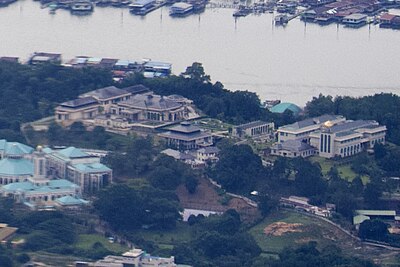
Search
Istana Darul Hana

The Istana Darul Hana (English: Darul Hana Palace) is one of the few remaining palaces in Brunei which notably, is the former residence of Omar Ali Saifuddien III from 1951 to 1987. The palace is located on a hill at Kilometer 3 of Jalan Tutong in Kampong Tumasek, Brunei-Muara District, Brunei. It is sometimes referred to as Istana Lama.
Name
The English translation of the two Arabic phrases "Darul Hana" is "Happy Country," and it has no religious connotations. It is widely believed that Sultan Omar Ali Saifuddien III named the palace "Darul Hana" after Sarawak, a former possession of the Brunei Sultanate. It can also be translated to "peace and tranquility."
Design and construction
Istana Darul Hana is built alongside and facing the Brunei River. It was first constructed from concrete and cement in 1950, and later completed in 1951. It covers an estimated area of 6 acres (2.4 ha). A few notable aspects of the palace is its water fountain, Show Room, Balai Singgahsana, and Regalia House. Since its completion, the palace has seen expansions and additions. This is the first palace constructed completely of cement. According to a 1974 report at the palace, "Extensions to Princesses' Apartments and Remodelling of the Store Roof" were noted. In 1977, the "Istana Banquat Hall Drawing" was completed which consisted of 2000 chairs and 200 tables.
History
Upon its completion in 1951, Sultan Omar Ali Saifuddien III would soon make it his official residence later year on 10 May. During its service period, it was regularly used to celebrate or commemorate royal engagements. Sultan Hassanal Bolkiah also received his early education by private tuition at the palace prior to attending top schools in both his country and Malaysia.
In order to compel the Sultan of Brunei to proclaim a Federal State of North Kalimantan during the 1962 Brunei revolt, the rebels of the Brunei People's Party had planned and attempted to kidnap the Sultan, but were not successful. His Majesty and his family were still at the palace on the night of the uprising, joined by a number of state dignitaries and six police officers.
Later on 29 July 1965, the wedding ceremony between then Crown Prince Hassanal Bolkiah and Pengiran Anak Saleha were held at the palace. The palace would once again be used for another national event which is the Sultan Omar Ali Saifuddien III's abdication in 1967, and its rule be transferred to his son, then Hassanal Bolkiah. Later in October 1969, the palace was used for the wedding of Princess Masna and Pengiran Anak Abdul Aziz.
There have been several other celebrations held at this palace, including notably when Prince Sufri Bolkiah was born on 31 July 1952, Prince Jefri Bolkiah on 6 November 1954, Princess Rashidah Sa'adatul Bolkiah on 26 July 1969, Princess Muta-Wakkilah Hayatul Bolkiah on 12 October 1971, and Prince Al-Muhtadee Billah on 17 February 1974.
It will continue be used until the completion of the new Istana Nurul Iman around 1987. As of 2009, it is one of the only three remaining active palaces that still exists in the country, with the other two being Istana Nurul Iman and Istana Nurul Izzah.
Gallery
See also
- Politics of Brunei
- Bandar Seri Begawan
- Istana Nurul Iman
References
External links
- Government of Brunei
Text submitted to CC-BY-SA license. Source: Istana Darul Hana by Wikipedia (Historical)
Owlapps.net - since 2012 - Les chouettes applications du hibou


